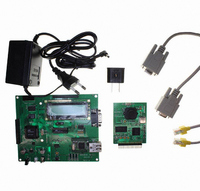ATWEBDVK-02WC Atmel, ATWEBDVK-02WC Datasheet - Page 14

ATWEBDVK-02WC
Manufacturer Part Number
ATWEBDVK-02WC
Description
KIT DEV TCP/IP AT89C51RD2 WEBCAM
Manufacturer
Atmel
Series
@Webr
Datasheet
1.ATWEBDVK-02RC.pdf
(137 pages)
Specifications of ATWEBDVK-02WC
Main Purpose
*
Embedded
*
Utilized Ic / Part
AT89C51RD2
Primary Attributes
*
Secondary Attributes
*
Lead Free Status / RoHS Status
Contains lead / RoHS non-compliant
- Current page: 14 of 137
- Download datasheet (2Mb)
5. Port Types
Figure 5-1.
14
AT89C51RD2/ED2
Port Latch
Data
Quasi-Bidirectional Output
AT89C51RD2/ED2 I/O ports (P1, P2, P3, P4, P5) implement the quasi-bidirectional output that
is common on the 80C51 and most of its derivatives. This output type can be used as both an
input and output without the need to reconfigure the port. This is possible because when the port
outputs a logic high, it is weakly driven, allowing an external device to pull the pin low. When the
pin is pulled low, it is driven strongly and able to sink a fairly large current. These features are
somewhat similar to an open drain output except that there are three pull-up transistors in the
quasi-bidirectional output that serve different purposes. One of these pull-ups, called the "weak"
pull-up, is turned on whenever the port latch for the pin contains a logic 1. The weak pull-up
sources a very small current that will pull the pin high if it is left floating. A second pull-up, called
the "medium" pull-up, is turned on when the port latch for the pin contains a logic 1 and the pin
itself is also at a logic 1 level. This pull-up provides the primary source current for a quasi-bidi-
rectional pin that is outputting a 1. If a pin that has a logic 1 on it is pulled low by an external
device, the medium pull-up turns off, and only the weak pull-up remains on. In order to pull the
pin low under these conditions, the external device has to sink enough current to overpower the
medium pull-up and take the voltage on the port pin below its input threshold.
The third pull-up is referred to as the "strong" pull-up. This pull-up is used to speed up low-to-
high transitions on a quasi-bidirectional port pin when the port latch changes from a logic 0 to a
logic 1. When this occurs, the strong pull-up turns on for a brief time, two CPU clocks, in order to
pull the port pin high quickly. Then it turns off again.
The DPU bit (bit 7 in AUXR register) allows to disable the permanent weak pull up of all ports
when latch data is logical 0.
The quasi-bidirectional port configuration is shown in Figure 5-1.
2 CPU
Clock Delay
Input
Data
P
N
Strong
AUXR.7
DPU
P
Weak
P
Medium
Pin
4235K–8051–05/08
Related parts for ATWEBDVK-02WC
Image
Part Number
Description
Manufacturer
Datasheet
Request
R

Part Number:
Description:
KIT DEV TCP/IP AT89C51RD2
Manufacturer:
Atmel
Datasheet:

Part Number:
Description:
KIT DEV TCP/IP AT89C51RD2 REMOTE
Manufacturer:
Atmel
Datasheet:

Part Number:
Description:
KIT DEV TCP/IP AT89C51RD2 VOIP
Manufacturer:
Atmel
Datasheet:

Part Number:
Description:
DEV KIT FOR AVR/AVR32
Manufacturer:
Atmel
Datasheet:

Part Number:
Description:
INTERVAL AND WIPE/WASH WIPER CONTROL IC WITH DELAY
Manufacturer:
ATMEL Corporation
Datasheet:

Part Number:
Description:
Low-Voltage Voice-Switched IC for Hands-Free Operation
Manufacturer:
ATMEL Corporation
Datasheet:

Part Number:
Description:
MONOLITHIC INTEGRATED FEATUREPHONE CIRCUIT
Manufacturer:
ATMEL Corporation
Datasheet:

Part Number:
Description:
AM-FM Receiver IC U4255BM-M
Manufacturer:
ATMEL Corporation
Datasheet:

Part Number:
Description:
Monolithic Integrated Feature Phone Circuit
Manufacturer:
ATMEL Corporation
Datasheet:

Part Number:
Description:
Multistandard Video-IF and Quasi Parallel Sound Processing
Manufacturer:
ATMEL Corporation
Datasheet:

Part Number:
Description:
High-performance EE PLD
Manufacturer:
ATMEL Corporation
Datasheet:

Part Number:
Description:
8-bit Flash Microcontroller
Manufacturer:
ATMEL Corporation
Datasheet:










